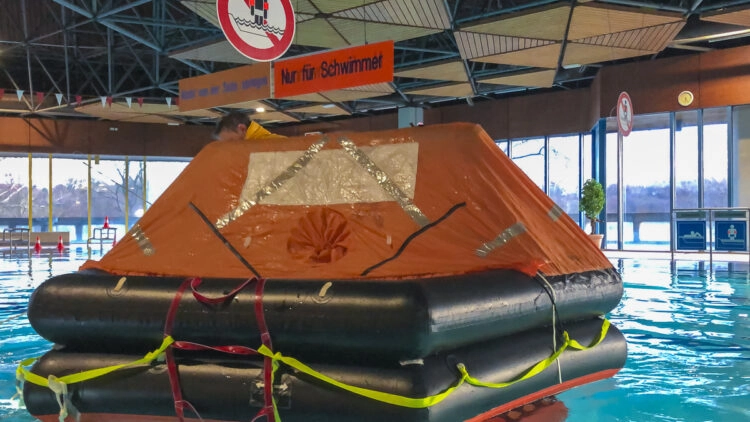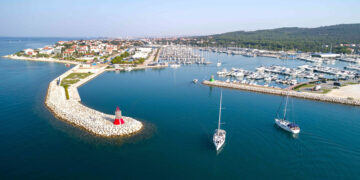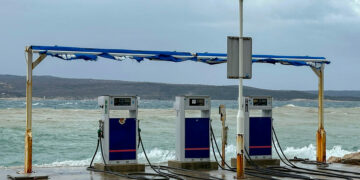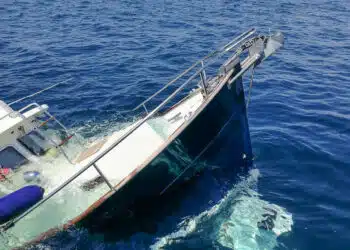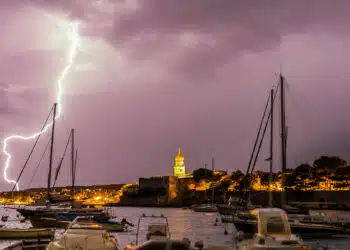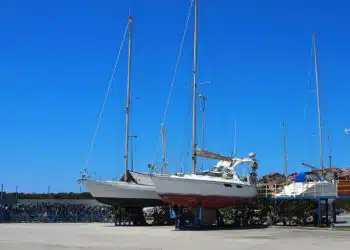They are mandatory for participation in ocean racing: Special safety training for sailors certified by World Sailing. Cruisers and charterers, on the other hand, never have to prove that they know how to use fire extinguishers and distress munitions and how to climb into a life raft. Actually, that’s wrong, because a marine emergency can happen to anyone. It’s good to know how to act correctly in an extreme case.
A sea safety training is interesting and important for all who go on tour together and not just move from one busy port to the next popular and correspondingly well-filled anchorage. And this for all crew members, not only for skipper or skipperess. In an emergency, it is important that everyone knows what needs to be done. Not only in theory, but also practically tested. Injuries can happen anywhere, and if it is the skipper who is affected, a crew member who is not supposed to be involved must be able to intervene. And regardless of whether it’s a regatta yacht or a family cruiser, most ships burn equally well. In this respect, every passenger should know where the fire extinguisher is located and how to operate it.
In a special safety training course, the use of life rafts and automatic vests is tested in the swimming pool, small fires are extinguished in open areas, and distress ammunition is test-fired. In addition, there are theory units in which the practical experience is deepened.
Special safety training for sailors
Only those who have once been in the water in oilskins – even if it is a well-tempered swimming pool – know how difficult it is to swim with fully soaked clothes. And only he knows the feeling of being kept afloat by a self-inflating life jacket. To recreate this emergency as realistically as possible, safety training participants bring their own oilskins and, if available, their own lifejacket.
Depending on the cruising area, it’s recommended to also put on rubber or sea boots for pool practice, as well as warm clothing under the oil stuff. This is the only way to best simulate how much effort it takes to swim in a particular direction with an inflated life jacket and clothing. On the other hand, it is much easier to let the vest keep you afloat while floating on your back.
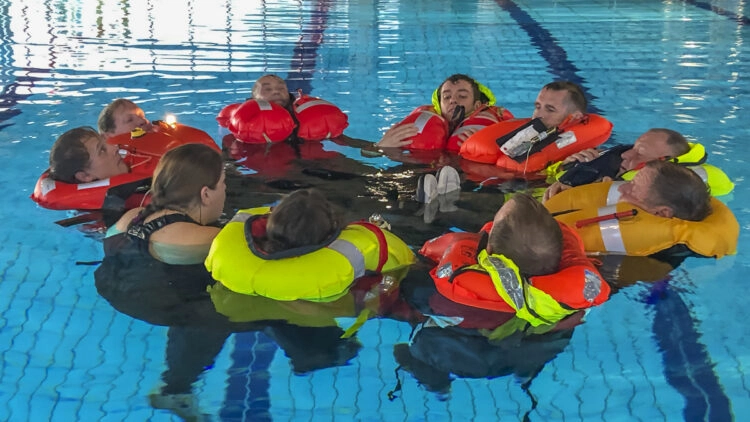
Sea emergency is simulated in the swimming pool
Likewise, the harmless exercise in the swimming pool shows that it is not so easy to climb over the wobbly rope ladder of the life raft to get into the life-saving, floating capsule. Even though there are no high waves in the turquoise-green tiled pool and the water is a relaxing 20 degrees: The rope ladder moves away from the body rather than toward it due to the swimmers’ body movements; climbing up the wobbly timbers requires good coordination and a lot of strength in the arms.
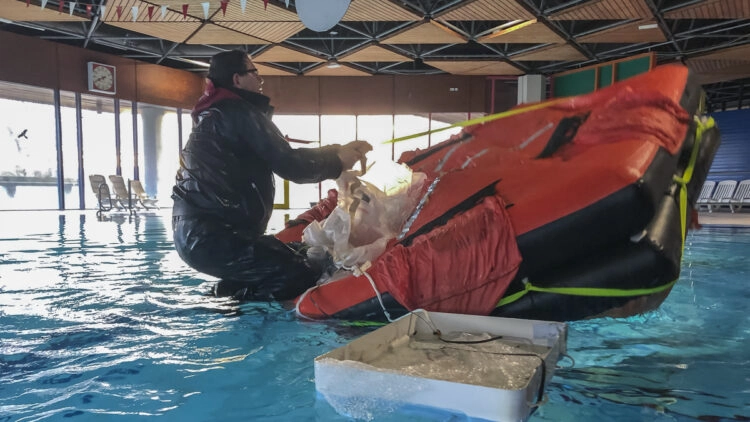
Once the maximum number of people for the life raft is reached, the hatches or zippers are also closed during the exercise in the swimming pool. It quickly becomes clear in this way that the liferaft is very cramped, very warm depending on the weather, and anyone prone to seasickness will feel the urgent need to get out quickly.
Emergency plans are being developed
But when is the right time to lower the life raft into the water and abandon the sinking or perhaps burning ship? That’s exactly what you learn in a maritime safety training course, which uses a good mix of theory and practice not only to teach the right way to behave in dangerous situations, but also to give you food for thought about the potential dangers on board.
How do you react correctly when the galley catches fire? I’m sure most of us remember that you don’t put out a grease fire with water and should try to smother the flames with a cloth. In a special safety training, everyone gets to try fighting a blazing fire with a conventional powder extinguisher. Whereas experts recommend placing a can of fire extinguishing spray near the galley, where most fires start on board. This spray – which is operated in the manner of a conventional hairspray can at the touch of a button – reliably and quickly extinguishes a localized, small source of fire and does not penetrate all the little cracks and nooks in the ship and cable ducts like the foam from fire extinguishers.
Correct use of marine distress ammunition
Also part of maritime safety training are learning about the various marine distress munitions and their proper use. When is an orange smoke pot that gives off its color for a long time a good way to be seen? When is it better to ignite a marine distress rocket that rises very high but burns out quickly?
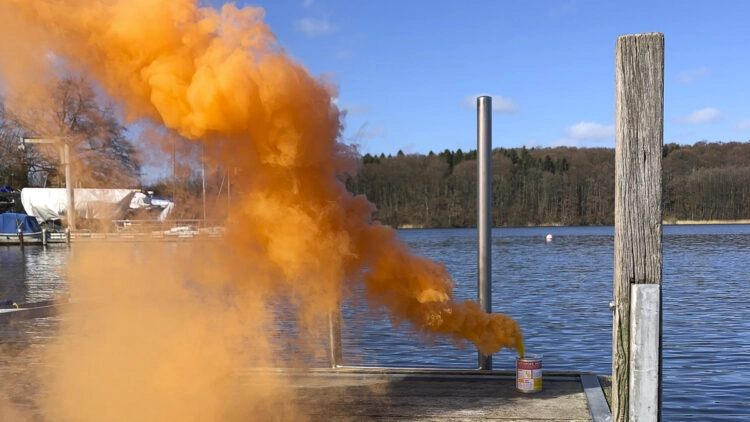
These practical exercises are combined with theoretical units in the seminars, when the sailors think about possible dangerous situations with themselves on board in the familiar crew constellation. Those who are touring for longer periods in lonely waters can prepare for emergencies with elaborated emergency plans that all crew members must know. These elaborated emergency rolls, which can be printed and laminated, for example, and stowed in the navigation corner for all to quickly access, are a useful addition to the mandatory safety briefing at the beginning of a cruise.
Interesting for all crew members
Other topics to be discussed at a special safety seminar for water sports enthusiasts include spill response, man-overboard maneuvers, first aid at sea, proper conduct in heavy weather and assistance in marine emergencies. It is important that all course participants learn how to correctly use the equipment available on board in an emergency.
Most of these courses take place as compact weekend seminars, where a group of up to 20 people go through all the theoretical and practical stations together and work out solution scenarios in small teams to problems set by the trainers. In particular, the exchange of ideas among the participants, who all have different levels of sailing experience, gives the seminar additional impetus and food for thought.
The special courses for safety at sea are offered by various sailing schools and associations. If you need proof of successful completion of the training for participation in a regatta or a squadron race, you should make sure when booking the course that it is one certified by World Sailing.
Depending on the provider, the courses cost around 350.00 euros. The World Sailing Federation recommends that the course be refreshed every five years. In Ratzeburg, Schleswig-Holstein, Team H3 has been organizing these training courses very successfully for many years in cooperation with a sailing club and the volunteer fire department. The program of the Akademie des Deutschen Segler-Verbandes also includes special sea survival training courses.
In western Germany, Sailing Island runs these courses in cooperation with the indoor swimming pool in Mönchengladbach. Sailors from Bavaria can book a corresponding seminar at Activesail in Nuremberg. In Austria, experienced offshore and Mintransat sailor Christian Kargl offers safety training certified by World Sailing.


